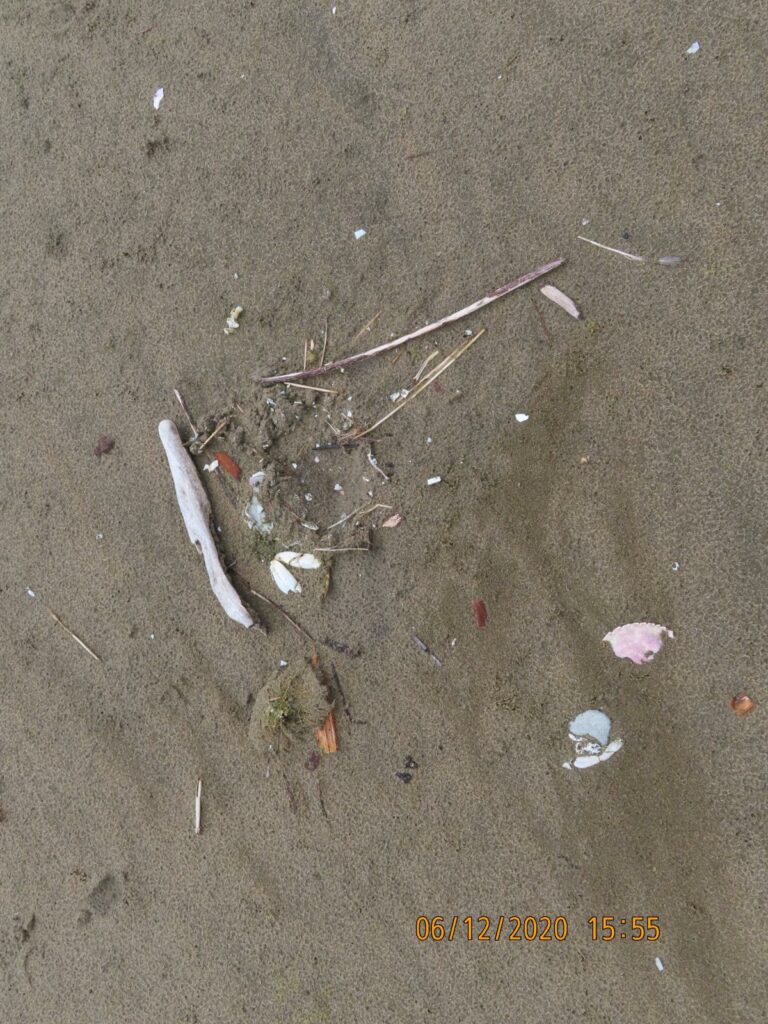Mile 203 Report
Driftwood Beach south, Hidden Lake
June 12, 2020
bonefire and campfire set upsSAND202001 Snowy Plover Nest FailedDriftwood Snowy Plover nest still ok.
Report Details
bonefire and campfire set upsSAND202001 Snowy Plover Nest FailedDriftwood Snowy Plover nest still ok.
Conditions
Temperature: 59 F. Cloud Cover: Sunny. Wind Velocity: Calm/Light. Wind Direction: SW. Tide Level: 3.5 feet.
Human Activities
Number of people: 48. Number of dogs: 12. Walking or running: 12. Playing in surf: 13. Playing in sand: 8. Sitting: 11. Other Activities: 1 drawing, 3 playing in dunes. no masks being worn, bonfire with starter fluid could be a hazard and pollution
Concerns
Climbing bluffs/seastacks
Apparent violations: building of bonfire piles with drift wood (pics attached).Disturbances: Disturbance of nesting seabirds
Notable Wildlife
Nesting Snowy Plover out of Mile 203 at Drift wood Sad to report nest SAND202001 most likely failed
Driftline Content
Small rocks, Seaweeds and seagrass, Shells, Animal casings (e.g., crab, shrimp molt), Wood pieces.








Report Images
All Mile 203 Reports
Mile 203
Driftwood Beach south, Hidden Lake
We found 7 lbs 12 oz of marine and ocean debris on the beaches in the wrackline area. The north and south ends of mile 203 show evidence of substantial wave erosion of the dunes.
Jeff Hildreth
Mile 203
Driftwood Beach south, Hidden Lake
The beach has had substantial washing away of old dunes and washing up of beach grass into the dunes. There were 45 bird carcasses of we believe are Cassin's auklets.
Jeff Hildreth
Mile 203
Driftwood Beach south, Hidden Lake
Today I and my two CoastWatch partners conducted a NOAA Marine Debris survey on our 100 meter survey site at Sandpiper Beach, Mile 203. On reaching our marine debris survey site, we saw a lot of Cassin's Auklet carcasses, which COASST calls CAAU, all high up on the beach among the beach vegetation and washed-in sea grass, many carcasses partially covered by sand or vegetation. After we completed our debris survey, I returned to our survey site and began collecting CAAU carcasses in groups of 9, as COASST recommends, ultimately collecting 40 carcasses in 4 full and 1 partial grouping. Below is a link to our Sandpiper Beach NOAA debris survey site where most CAAUs were found, reached by a boardwalk that enters the beach midway in the debris survey site. COASST defines a "wreck" as more than 20 beached individuals of one species per kilometer, and a "MME" (Massive Mortality Event) as a spike of up to hundreds of carcasses per kilometer. We also found a beached Northern Fulmar and what is I believe was either a female Gadwall or White-winged Scoter, which I took note of but didn't measure or report on to COASST. I submitted documentation with photos of the CAAU beaching event to COASST, and COASST responded that they had received reports of CAAU beachings from Southern Oregon sites like Coquille Point and Cape Blanco but also as far north as Manzanita. All this sounds very dry, but it was really sad to see and handle all these beautiful little dead birds and wonder if this is completely natural or if climate change, and perhaps a decline of prey species making these birds more vulnerable, factors into these mortality events. https://mdmap.
Jon French
Mile 203
Driftwood Beach south, Hidden Lake
The storms and rain caused some beach washout from the ocean and from the land.
JLcoasties
Mile 203
Driftwood Beach south, Hidden Lake
The dunes have reappeared due to the spring winds.
JLcoasties
Mile 203
Driftwood Beach south, Hidden Lake
Last year at this time, Jesse Jones helped us set up a 100 meter NOAA marine debris survey site on Mile 204, which we later moved to Sandpiper Beach on Mile 203.
Jon French
Mile 203
Driftwood Beach south, Hidden Lake
It was a beautiful day for a walk.
Nancy Thomas
Mile 203
Driftwood Beach south, Hidden Lake
After observing 8 snowy plovers on Mile 200 yesterday, I wanted to check up on the plovers on Mile 203.
KFunk








